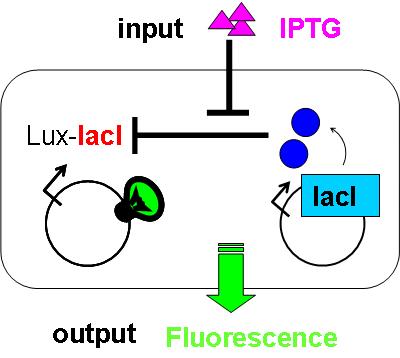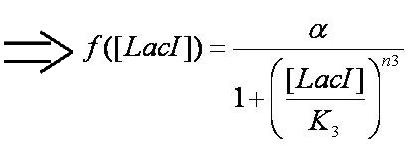Tokyo/Hill function fitting
From 2007.igem.org
(→Deviation of Hill function) |
|||
| Line 16: | Line 16: | ||
<br> | <br> | ||
'''1.Hill function for the activator AHL''' | '''1.Hill function for the activator AHL''' | ||
| - | [[Image:hill-fitting-1.jpg|200px|right|thumb| | + | [[Image:hill-fitting-1.jpg|200px|right|thumb|'''Fig. 1''' AHL absorbed in a cell binds to LuxR to make a complex, which activates the lax lac hybrid promoter and expression of GFP downstream of it. In this way, a cell recieves AHL as an input and gives off green fluorescence as its output. ]] |
Without the repression by LacI( [LacI]=0 ), Ex.6.1 was described as | Without the repression by LacI( [LacI]=0 ), Ex.6.1 was described as | ||
<br>[[Image:expression6-4.JPG|300px|none|thumb|Ex.6.2]] | <br>[[Image:expression6-4.JPG|300px|none|thumb|Ex.6.2]] | ||
Revision as of 13:34, 25 October 2007
Works top 0.Hybrid promoter 1.Formulation 2.Assay1 3.Simulation 4.Assay2 5.Future works
Purpose of this assay 1.AHL assay 2.IPTG assay Preliminary assays
Purpose:
We have conducted the assays to obtain parameters in the Hill function expressing our model.
The how the hill function is deviated is described below.
Deviation of Hill function
1.Hill function for the activator AHL
Without the repression by LacI( [LacI]=0 ), Ex.6.1 was described as
Therefore, in the steady state the Hill function for the activator AHL was given as
2.Hill function for the repressor LacI
When the concentration of AHL was assumed to be infinity, Ex.6.1 was described as
Therefore, in the steady state the Hill function for the repressor LacI was given as
However, the amount of LacI cannot be actually measured.So,we used the inducer IPTG to calculate the Hill function for LacI.
Assume that the reaction between [LacI] and [IPTG] is the equilibrium reaction,these concentration in equilibrium state were shown in Fig.3.
Therefore,the equilibrium constant k0 was obtained as
Moreover, assume that [IPTG]_total was more than [LacI=IPTG] predominantly,
By substituting Ex.6.9 into Ex.6.8, [LacI] was obtained as
As a result, by substituting Ex.6.10 into Ex.6.7,the Hill function for LacI was obtained as the function of [IPTG]total,
Here k0=0.0337(/μM),[LacI]total=140(μM).













